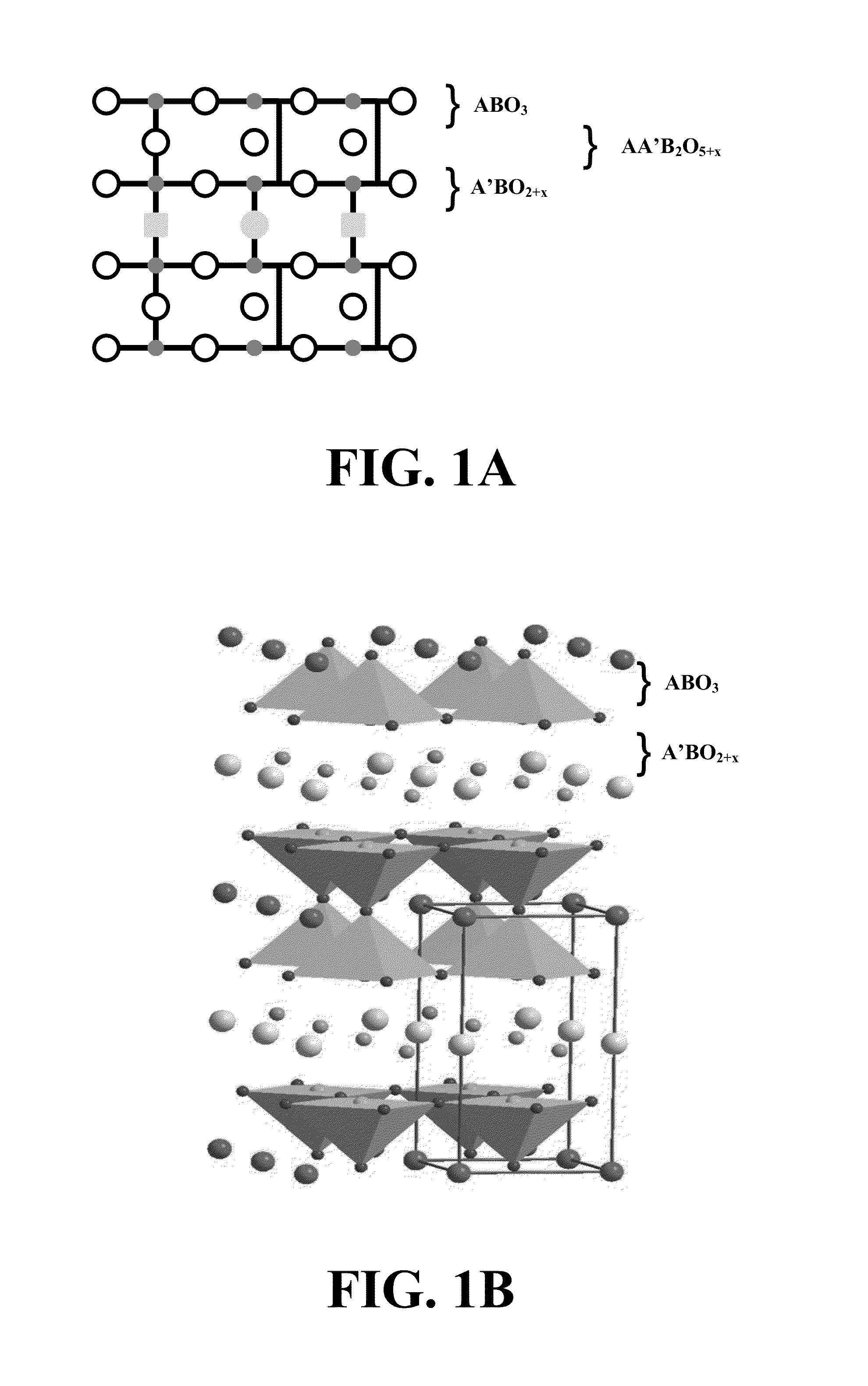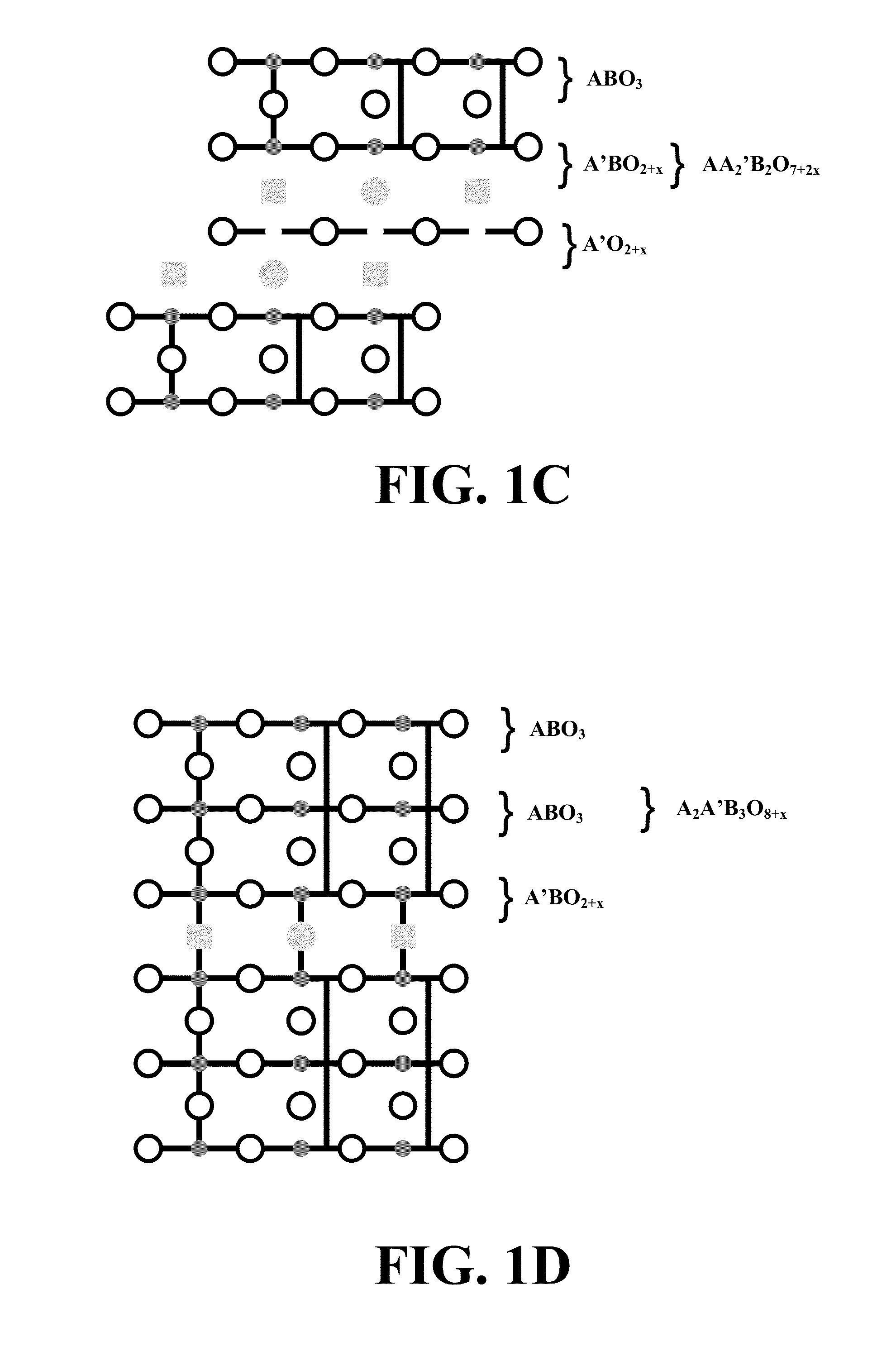Methods for using novel cathode and electrolyte materials for solid oxide fuel cells and ion transport membranes
- Summary
- Abstract
- Description
- Claims
- Application Information
AI Technical Summary
Benefits of technology
Problems solved by technology
Method used
Image
Examples
example 1
[0070]This example illustrates the synthesis of PrBaCo2O5+x, and NdBaCo2O5+x, via a citrate precursor method. Stoichiometric amounts of Pr6O11(Alfa 99.99%) or Nd(NO3)2, and barium and cobalt nitrates (Aldrich, 99.99%), were dissolved in dilute nitric acid. Ethylene glycol (EM science >98%) and citric acid (Aldrich, 99.5%) were added to the solution. This mixtures were covered and stirred at 150° C. until the solutions began to foam and formed dry resins. Further heating at 300° C. and then 600° C. for 24 hours decomposed the dry foams containing residual organic components. The final mixtures were pressed into pellets and sintered in air at 1100° C. for 12 hours and the cooled to room temperature in a nitrogen atmosphere. X-ray diffraction patterns of the final products confirmed the formation of single phases of PrBaCo2O5+ and NdBaCo2O5+.
example 2
[0071]This example shows the variation of the DC conductivity of PrBaCo2O5.5+x and NdBaCo2O5.5+X. The total conductivity was measured by the 4-probe method at pO2=0.01 and 0.21 atm in the range 25° C.≦T° C.≦812° C. The measurements were made AC at a single frequency (1 kHz) using a dual-phase lock-in amplifier (Stanford Instruments Model SR830). The total conductivity was measured on rectangular bars of PrBaCo2O5.5+x (1.3×0.19×0.15 cm) and NdBaCo2O5.5+x (1.4×0.2×0.21 cm). Near ambient temperature, the conductivities reach 600 Scm−1 and 1000 Scm−1 for the Pr and Nd compounds, respectively (FIG. 2). As the temperature is increased, the conductivities begin to decrease at ˜150° C. due to the loss of oxygen atoms from the lattices and reduction of Co(IV) to Co(III). The data indicate that the onset temperature for oxygen loss is slightly lower for the Nd compound. The occurrence of oxygen loss at such low temperature indicates that the high mobility of oxygen ions in these phases.
example 3
[0072]This example shows the high value of the oxygen transport kinetics in of PrBaCo2O5.5+ and NdBaCo2O5.5+ by measurement of the diffusion coefficient and surface exchange coefficient by electrical conductivity relaxation in the temperature range between about 300° C. and about 450° C. The measurements were made AC at a single frequency (1 kHz) using a dual-phase lock-in amplifier (Stanford Instruments Model SR830). Measurements were made with an abrupt gas switch on both oxidation and reduction and were performed twice at each gas switch and temperature. The self diffusion coefficients and surface exchange coefficients are shown in FIGS. 2 and 3. These values are remarkably high at such low temperature in comparison with other materials.
PUM
 Login to View More
Login to View More Abstract
Description
Claims
Application Information
 Login to View More
Login to View More - R&D
- Intellectual Property
- Life Sciences
- Materials
- Tech Scout
- Unparalleled Data Quality
- Higher Quality Content
- 60% Fewer Hallucinations
Browse by: Latest US Patents, China's latest patents, Technical Efficacy Thesaurus, Application Domain, Technology Topic, Popular Technical Reports.
© 2025 PatSnap. All rights reserved.Legal|Privacy policy|Modern Slavery Act Transparency Statement|Sitemap|About US| Contact US: help@patsnap.com



